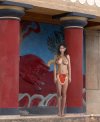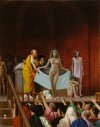-
Sign up or login, and you'll have full access to opportunities of forum.
You are using an out of date browser. It may not display this or other websites correctly.
You should upgrade or use an alternative browser.
You should upgrade or use an alternative browser.
Cam's Camera: Slave Girls
- Thread starter CamCrux
- Start date

This is a beautiful example of a slave girl portrait, presented in high resolution. The location is immediately identifiable as the Minoan Palace at Knossos, and the girl waits patiently, with lowered eyes, before being directed to a new task. Often the best results can be achieved by keeping the composition simple, whilst concentrating on the fine detail in a large scale, as we see here.
Alisa has featured in some of Kam's earlier pictures, so he is familiar with her proportions - a vital consideration when transplanting a major component like the face of another subject. Parts of Alisa's hair remain visible, particularly on the shoulders, and the new face has been added by blending the surrounding hair into that of the original figure. The effect is so successful that the work involved is not noticeable, unless we look very closely at the differences in the original figure.
Alisa has been sourced from a Femjoy series with the slightly unimaginative title of 'Wow', by Stefan Soell. These studio poses showcase a long legged figure, standing 5' 9" in height. In designer terms, she is a genuine 'eight heads tall' fashion model, without shoes. Pictures of the first floor gallery containing the minotaur fresco are plentiful, but none show a human being, so the scale is conjectural. However, Kam has ensured that both figure and background share a compatible, low viewpoint, with the eye level somewhere around the ankles - and this appears entirely convincing.
The body has been carefully extracted, with a smooth outline, from the source photo, and flipped to ensure a consistent direction of lighting with the new face and background. All components are presented in soft, ambient light, with colour saturations appropriately balanced.
Alisa's necklace is the kind of ornament which is suitable for a highly valued slave - one who also qualifies for a lustrous, orange loincloth, trimmed in gold lame. Kam has added this as a separate component, paying careful attention to the shadow it casts on the right thigh. She also casts a soft shadow on the ground, which has been convincingly blurred beside the right foot. A separately applied armlet in a blue colour completes the adornments. The colours being worn are all reflected in the red, blue and gold colours of the fresco, and the skin tone reflects the unpainted stonework.
All of this contributes to the overall, sympathetic colour blending, but such details only become evident on close examination. Otherwise, as viewers have already observed, the girl simply looks as if she has always belonged in the scene, and the work undertaken by the artist is not apparent. This picture shows the latest refinements in the artist's technique and the result is very fine indeed. Well done, Kam!

She's very nice too. I might "borrow" some bits of her as well.Correction : the head was borrowed from model Lana G.

theseus
SERVILIS CURATOR
Back in the 1960 an author by the name of Mary Renault wrote a novel about Theseus in the Bull Court at Knossos. He had a ten of seven young men and seven Young women who danced with the bulls as depicted in the Bull Leaper fresco at Knossos. It would be wonderful if one of our skilled artists could do a series based on this story. I would be happy to write the text if there were pictures to write too. Attached are some pics that give and idea of the scene.
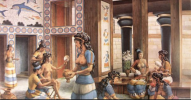 The court at Knossos was luxurious. They had running water and flushing toilets. Men wire brief kilts and women voluminous skirts with bare breasts.
The court at Knossos was luxurious. They had running water and flushing toilets. Men wire brief kilts and women voluminous skirts with bare breasts.
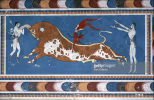 The bull dancers danced almost nude, both sexes wearing just the brief kilts and jewellery. In this fresco the dark figure is male and the pale female. The women would have been small breasted and athletic, like modern gymnasts
The bull dancers danced almost nude, both sexes wearing just the brief kilts and jewellery. In this fresco the dark figure is male and the pale female. The women would have been small breasted and athletic, like modern gymnasts
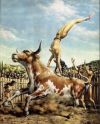
I'm not sure whether the book is still available. The title was "The King Must Die." It inspired my choice of avatar.
 The court at Knossos was luxurious. They had running water and flushing toilets. Men wire brief kilts and women voluminous skirts with bare breasts.
The court at Knossos was luxurious. They had running water and flushing toilets. Men wire brief kilts and women voluminous skirts with bare breasts. The bull dancers danced almost nude, both sexes wearing just the brief kilts and jewellery. In this fresco the dark figure is male and the pale female. The women would have been small breasted and athletic, like modern gymnasts
The bull dancers danced almost nude, both sexes wearing just the brief kilts and jewellery. In this fresco the dark figure is male and the pale female. The women would have been small breasted and athletic, like modern gymnasts
I'm not sure whether the book is still available. The title was "The King Must Die." It inspired my choice of avatar.
Indeed, the 'author by the name of Mary Renault' was one of the finest historical novelists of the mid-20th century. Her works, of which 'The King Must Die' is regarded as one of the finest, are certainly still available - they were republished by the feminist press, Virago. This extract from the Wiki article gives a good account of her, and her opinions - advanced for their time, though later controversial:
In South Africa, Renault was able to write forthrightly about homosexual relationships for the first time. Her sympathetic treatment of love between men won her a wide gay readership, but it also led to rumours that Renault was really a gay man writing under a female pseudonym. Renault found these rumours amusing but also sought to distance herself from being labelled a "gay writer".
Her historical novels are all set in ancient Greece. They include a pair of novels about the mythological hero Theseus and a trilogy about the career of Alexander the Great. In a sense, The Charioteer (1953), the story of two young gay servicemen in the 1940s who try to model their relationship on the ideals expressed in Plato's Phaedrus and Symposium, is a warm-up for Renault's historical novels. By turning away from the twentieth century and focusing on stories about male lovers in the warrior societies of ancient Greece, Renault no longer had to deal with homosexuality and anti-gay prejudice as social "problems". Instead, she was free to focus on larger ethical and philosophical concerns while examining the nature of love and leadership. The Charioteer could not be published in the US until 1959, which made it a somewhat later addition to homosexual literature in the United States because American readers and critics had accepted serious gay love stories in such works as Djuna Barnes' Nightwood (1936), Carson McCullers' Reflections in a Golden Eye (1941), Truman Capote's Other Voices, Other Rooms (1948) and Gore Vidal's The City and the Pillar (1948).[9]
Although not a classicist by training, Renault was admired in her day for her scrupulous recreations of the ancient Greek world. Some of the history presented in her fiction and in her non-fiction work, The Nature of Alexander, has been called into question, however.[10] Her novels about Theseus rely on the controversial theories of Robert Graves, and her portrait of Alexander has been criticized as uncritical and romanticised.[11] According to Kevin Kopelson, professor of English at the University of Iowa, Renault "mischaracterise pederastic relationships as heroic."[12] Defying centuries of admiration for Demosthenes as a great orator, Renault portrayed him as a cruel, corrupt and cowardly demagogue. Renault defended her interpretation of the available sources in author's notes attached to her books.
In South Africa, Renault was able to write forthrightly about homosexual relationships for the first time. Her sympathetic treatment of love between men won her a wide gay readership, but it also led to rumours that Renault was really a gay man writing under a female pseudonym. Renault found these rumours amusing but also sought to distance herself from being labelled a "gay writer".
Her historical novels are all set in ancient Greece. They include a pair of novels about the mythological hero Theseus and a trilogy about the career of Alexander the Great. In a sense, The Charioteer (1953), the story of two young gay servicemen in the 1940s who try to model their relationship on the ideals expressed in Plato's Phaedrus and Symposium, is a warm-up for Renault's historical novels. By turning away from the twentieth century and focusing on stories about male lovers in the warrior societies of ancient Greece, Renault no longer had to deal with homosexuality and anti-gay prejudice as social "problems". Instead, she was free to focus on larger ethical and philosophical concerns while examining the nature of love and leadership. The Charioteer could not be published in the US until 1959, which made it a somewhat later addition to homosexual literature in the United States because American readers and critics had accepted serious gay love stories in such works as Djuna Barnes' Nightwood (1936), Carson McCullers' Reflections in a Golden Eye (1941), Truman Capote's Other Voices, Other Rooms (1948) and Gore Vidal's The City and the Pillar (1948).[9]
Although not a classicist by training, Renault was admired in her day for her scrupulous recreations of the ancient Greek world. Some of the history presented in her fiction and in her non-fiction work, The Nature of Alexander, has been called into question, however.[10] Her novels about Theseus rely on the controversial theories of Robert Graves, and her portrait of Alexander has been criticized as uncritical and romanticised.[11] According to Kevin Kopelson, professor of English at the University of Iowa, Renault "mischaracterise pederastic relationships as heroic."[12] Defying centuries of admiration for Demosthenes as a great orator, Renault portrayed him as a cruel, corrupt and cowardly demagogue. Renault defended her interpretation of the available sources in author's notes attached to her books.
theseus
SERVILIS CURATOR
My own introduction to Mary Renault was in the mid sixties, when her novel, The Mask of Apollo, was serialised on radio. I was in my early teens at the time, passionately interested in ancient Greece (I had found a copy of Arthur Evans’ “The Palace of Minos at Knossos” in the city library and ploughed my way through it.) and wanting to become an archaeologist. I found all her books, all of which, tattered and often reread, still occupy my bookshelves more than half a century later.
A few years later, while at the Naval Academy, I had the good fortune to meet her through two of my classmates who were part of her circle, and for a while to become one of the group of young people who met at her house at The Glen on Sunday evenings. These were an eye opener for a conservative, straight young man, and certainly opened my eyes and broadened my mind.
Mary was a nurse by training, and had some interesting experiences during the war. She became a patron of our ballet company (No! I am not a dancer, but I enjoy ballet and ballerinas and eventually married one more than 40 years ago.) and contributed to its continued existence.
I know that her novels are not totally accurate from a historical point of view, but they are novels, after all. Certainly, when I first went to Knossos in the 1970’s, and for a small douceur gained access to the site at dawn, just my girlfriend (now, and still, wife) and I, her images brought the place to life. I think she captured the spirit of the time, and particularly the Bull Court. Standing at the theatre at Delphi, my imagination could hear the speech of Nikeratos, wearing his old, frightening mask of Apollo on the god walk, that drove the attackers who broke the sacred truce, away in disarray.
I owe Mary a lot.
A few years later, while at the Naval Academy, I had the good fortune to meet her through two of my classmates who were part of her circle, and for a while to become one of the group of young people who met at her house at The Glen on Sunday evenings. These were an eye opener for a conservative, straight young man, and certainly opened my eyes and broadened my mind.
Mary was a nurse by training, and had some interesting experiences during the war. She became a patron of our ballet company (No! I am not a dancer, but I enjoy ballet and ballerinas and eventually married one more than 40 years ago.) and contributed to its continued existence.
I know that her novels are not totally accurate from a historical point of view, but they are novels, after all. Certainly, when I first went to Knossos in the 1970’s, and for a small douceur gained access to the site at dawn, just my girlfriend (now, and still, wife) and I, her images brought the place to life. I think she captured the spirit of the time, and particularly the Bull Court. Standing at the theatre at Delphi, my imagination could hear the speech of Nikeratos, wearing his old, frightening mask of Apollo on the god walk, that drove the attackers who broke the sacred truce, away in disarray.
I owe Mary a lot.
Back in the 1960 an author by the name of Mary Renault wrote a novel about Theseus in the Bull Court at Knossos. He had a ten of seven young men and seven Young women who danced with the bulls as depicted in the Bull Leaper fresco at Knossos. It would be wonderful if one of our skilled artists could do a series based on this story. I would be happy to write the text if there were pictures to write too. Attached are some pics that give and idea of the scene.
View attachment 1011730The court at Knossos was luxurious. They had running water and flushing toilets. Men wire brief kilts and women voluminous skirts with bare breasts.
View attachment 1011727The bull dancers danced almost nude, both sexes wearing just the brief kilts and jewellery. In this fresco the dark figure is male and the pale female. The women would have been small breasted and athletic, like modern gymnasts
View attachment 1011728
I'm not sure whether the book is still available. The title was "The King Must Die." It inspired my choice of avatar.
I grew up with these illustrations, and the snake dancers. It must be time that fashion made a comeback?
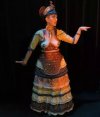

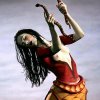
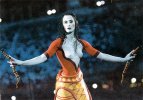
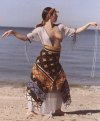
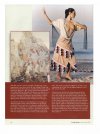
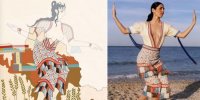
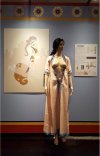
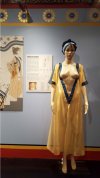
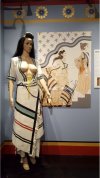
CamCrux
Magistrate
Another slavegirl fantasy in collaboration with Sclava / Keigera of Deviant Art.
The full story by Sclava is on my DA page. I made an alternative picture for this one, after a remark by a fan that the first girl did not look Egyptian...
that the first girl did not look Egyptian...


The full story by Sclava is on my DA page. I made an alternative picture for this one, after a remark by a fan
 that the first girl did not look Egyptian...
that the first girl did not look Egyptian...

Maybe you do add a shadow for the Slavegirl. That would be perfect.Another slavegirl fantasy in collaboration with Sclava / Keigera of Deviant Art.
The full story by Sclava is on my DA page. I made an alternative picture for this one, after a remark by a fanthat the first girl did not look Egyptian...
View attachment 1013315 View attachment 1013326
CamCrux
Magistrate
Maybe in a deeper layer.Oops, where did the shadow go ?
CamCrux
Magistrate
Or I made it invisible unintentionally ...Maybe in a deeper layer.
Sclava's tragic tale reads in an objective, documentary style, and yet there is tension and suspense in her desperate attempt to escape and remain hidden. This contrasts with her submission after capture, and the initial illustration evokes the sense of sadness and reflects the sudden loss of family, friends and freedom.
The low elevation, evening sunlight casts long shadows, and the sharp definition of light and shade on the rocks reflects the contrasts within the story. The girl, her shadow and the tethering rope are probably the only inserted components, but they have been blended in sympathy with the lighting and colouring of the background. Her shadow is very neatly applied, and ensures that the figure appears solid and realistic within the scene.
The rocky terrain offers numerous hiding places for the friend who remains undiscovered, and we can empathise with the captured girl's regrets about her failed concealment, and her fears about the life of slavery which lies ahead. Accepting her fate, she stands upright on slender legs, head bowed with a halter around her neck, somewhat like the creature to which she is secured.
The mood is slightly different in the second version. The new figure has strong chiaroscuro, which is arguably more suitable for the strong lighting of the background. She also has simpler bindings, which seem more convincing, and is located nearer to the centre of the composition.
The foreground has been adjusted for the appropriate movement of her shadow as well as the addition of the plant obscuring her feet (perhaps she wears shoes in the source image?) I think this is a very successful and worthwhile variation, although both images are equally attractive and reveal a close collaboration between artist and author. Nice work, Kam!

Yes, I like the stance and expression of #2, conveying to me a mixture of anxiety and determination.The mood is slightly different in the second version. The new figure has strong chiaroscuro, which is arguably more suitable for the strong lighting of the background. She also has simpler bindings, which seem more convincing, and is located nearer to the centre of the composition.
Gerome's slave market paintings are proving very popular with manip artists, and this is one which you have employed to good effect previously. The brickwork of the background has been extended to conceal the original figures, and several components have been inserted, including separate collars for the girls, and the short shift on the right hand figure (a clothing item which also appeared in 'The Hostage (2)').
The seated girl is a convincing substitute for Gerome's model, occupying the same position, and the poses of all three inserted figures, with their uncertain expressions, are particularly appropriate for this scene. The chain on the wall is a neatly applied emblem of captivity, and the moment of revelation by the central figure seems to justify the enthusiastic bidding.
I do not know the identities of the models, but the composition is both dramatic and appealing. Well done, Kam!

CamCrux
Magistrate
The central figure is known as Putri. I don't know who the other two are.I do not know the identities of the models, but the composition is both dramatic and appealing. Well done, Kam!
CamCrux
Magistrate
Kam-Aqhat's slavegirls : (1) Meri
Kam-Aqhat is a minor official at the court of Pharaoh Neb-khepesh-Re, also known as Apophis or Apepi, in Avaris.He owns four slavegirls. His most recent acquisition is Meri, captured in the eastern desert by Kam-Aqhat himself.
Look higher up for Sclava - Meri's account of her capture.



